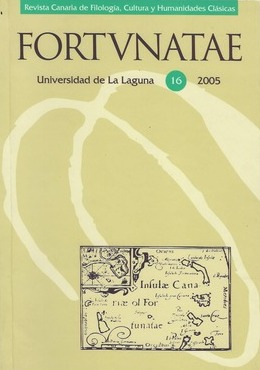Aproximación a la poesía desde el mito y el ritual
Resumen
La poesía, siguiendo las directrices de la Poética de Aristóteles, puede ser considerada en estrecha relación con el mito y el ritual. Las tres entidades, efectivamente, poseen en común el rasgo de ser conjuntos de signos redirigidos. La poesía es, en sí misma, como el mito, indiferente a determinados criterios comunes que, sin embargo, afectan al uso normal del lenguaje. Y, por otro lado, la poesía es, como el ritual, mimética, dramática, analógica y mágica.
Citas
AUSTIN, J. L. (1962): How to do Things with Words, The M. I. T. Press, Cambridge, pp. 94-108.
AUSTIN, J. L. (19702): Philosophical Papers, Oxford Clarendon Press.
AUSTIN, J. L. (1971): Palabras y acciones, Traducción española, Paidós, Buenos Aires.
AUSTIN, J. L. (1982): Cómo hacer cosas con palabras, Traducción española, Paidós, Buenos Aires.
AUSTIN, J. L. (1975): Ensayos filosóficos, Traducción española, Revista de Occidente, Madrid.
BAJTÍN, M. M. (1992): El marxismo y la filosofía del lenguaje, Traducción española, Alianza, Madrid.
BAKHTINE, M. (1984): Esthétique de la création verbale, Trad. fr., Gallimard, París.
BOOTH, W. (1974): A Rhetoric of Irony, The University of Chicago Press.
BOOTH, W. (19872): A Rhetoric of Fiction, Penguin, Harmondsworth.
DEACON, T. (1997): The Symbolic Species: The Co-Evolution of Language and the Brain, Norton, N. York.
ESKIN, M. (2000): «Bakhtin on Poetry», Poetics Today 21, pp. 379-391.
FERNANDEZ, J. (1974): «The mission of metaphor in expressive culture», Current Anthropology 15, pp. 119-46.
GANS, E. (1997): Signs of Paradox. Irony, Resentment, and Other Mimetic Structures, Stanford University Press, Stanford, California.
GENNEP, A. VAN, (1960): The Rites of Passage, trad. ingl.,Chicago, Chicago University Press. Aparecido en 1909.
HIRSCHKOP, K. (1989): «Dialogism as a Challenge to Literary Criticism», en C. Kelly-M. Makin-D. Shepherd (eds.), Discontinuous Discourses in Modern Russian Literature, St. Martin’s, N. York, pp. 19-35.
HOLQUIST, M. (ed.) (1992): M. M. Bakhtin. The Dialogic Imagination: Four Essays, Traducción inglesa, University of Texas Press, Austin, pp. 287-288.
JAKOBSON, R. (1960): «Linguistics and Poetics», en T. Sebeok, Style in language, The MIT Press & J. Wiley, Nueva York-Londres, pp. 350-377. [Versión española parcial en Estilo en el lenguaje, Cátedra, Madrid, 1974.]
LEECH, N. G.-M. H. SHORT (1995): A Style in Fiction. A Linguistic Introduction to English Fictional Prose, Longman, Londres.
LEVIN, S. R. (1974): Estructuras lingüísticas en la poesía, Traducción española, Cátedra, Madrid.
LEVINSON, S. (1983): Pragmatics, Cambridge University Press, Cambridge.
LEVINSON, S. (1988): «Putting Linguistics on a Proper Footing: Explorations in Goffman’s Concept of Participation», en P. Drew-A. Wootton, Erving Goffman. Exploring the Interaction Order, Polity Press, Cambridge, pp. 161-227.
RAPPAPORT, R. A. (19842): Pigs for the Ancestors: Ritual in the Ecology of a New Guinea People, Yale University Press, New Haven, 19681.
RAPPAPORT, R. A. (2002): Ritual and Religion in the Making of Humanity, Cambridge University Press.
TAMBIAH, S. J. (1973): «Form and meaning of magical acts: A point of view», en R. Horton-R. Finnegan (eds.), Modes of Thought: Essays on Thinking in Western and Non-Western Societies, Faber and Faber, Londres.
VALENTE, J. A. (1971): Las palabras de la tribu, Siglo XXI; Tusquets Editores, Barcelona, 1994-2.
Los autores conservan los derechos de autor y garantizan a la revista el derecho de ser la primera publicación del trabajo al igual que licenciarlo bajo una Creative Commons Attribution License que permite a otros compartir el trabajo con un reconocimiento de la autoría del trabajo y la publicación inicial en esta revista.
Los autores pueden establecer por separado acuerdos adicionales para la distribución no exclusiva de la versión de la obra publicada en la revista (por ejemplo, situarlo en un repositorio institucional o publicarlo en un libro), con un reconocimiento de su publicación inicial en esta revista.





